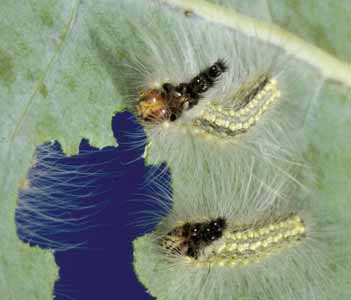PESTS AND DISEASES OF FORESTRY IN NEW ZEALAND
Gum leaf skeletoniser: long-term management programme producing results
From Biosecurity 53, August 2004.
The programme to provide tools for the management of the Australian insect pest gum leaf skeletoniser (Uraba lugens) is producing positive results. The gum leaf skeletoniser management programme was established by MAF to combat the effect that this defoliating insect would have on host species in New Zealand (see Biosecurity 47, November 2003). Forest Research and HortResearch as lead contractors have made good progress in their quest to find out more about the pest, resulting in useful information for future actions. One of the research projects is being led by Dr Darren Kriticos, Forest Research, and involves population dynamics modelling, part of which is aimed at determining the potential distribution of the gum leaf skeletoniser in New Zealand (Biosecurity 52:15). Interim results highlight that the pest has the potential to extend throughout most of the North Island, and in the South Island over much of the Canterbury Plains, Marlborough as well as portions of Southland, Otago Nelson and Tasman. Some uncertainty exists as to the effect of excessive rainfall and prolonged water logging of gum leaf skeletoniser and further work is required in this and other areas. Forest Research will be continuing its research into the population dynamics through to June 2005. At the conclusion of this research, findings will be summarised in a way that allows forest managers to decide when and where to apply different control tactics for the pest.

The synthetic pheromone for the gum leaf skeletoniser developed by Dr Max Suckling and his team at HortResearch, is proving very useful in tracking the spread of the pest in Auckland, as well as providing data to feed into several projects such as phenology modelling (the relationship between insect’s life cycle and environmental conditions) and population sampling. Dispersion studies carried out in 2003/04 show that the area of highest density continued to be southwest of Auckland, with some expansion of the pest distribution in the margins. As yet, activity has not been found outside the Auckland region. (An infestation of gum leaf skeletoniser found in Mt. Maunganui in the 1990s appears to have been eliminated.)
Other projects currently on the go include introduction of biological control agents from Australia, assessing the impact on host species and investigation into enhanced spray formulations for chemical control.
Programme work will continue into the 2004/05 financial year and as projects are signed off the resulting information will be transferred through a variety of methods to forest owners, councils and other interested stakeholders. To assist in this process and to integrate long-term management of this programme, MAF has established a stakeholder advisory group.
In the long term, it is hoped that any impact that the gum leaf skeletoniser will have in New Zealand will be lessened through the production of a range of cost effective biological and chemical management tools.
Mark Ross, National Adviser, Pest Surveillance and Response, Forest Biosecurity, MAF.

 Farm Forestry New Zealand
Farm Forestry New Zealand

